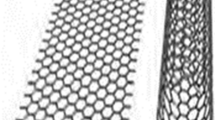Abstract
An ultra-thin film of functional molecule(s) can be deposited on an electrode, which then serves as a device to amperometrically monitor compounds of biological interest. The methods of surface functionalization, mostly on tin oxide (SnO2) electrodes, include: chemical modification (covalent bond formation between the surface OH group with a functional group of a molecule); the Langmuir-Blodgett technique, where the NH2 group of a long-chain alkylamine is bound to an enzyme via a small dialdehyde molecule as spacer; and electropolymerization of pyrrole in an electrolyte containing a single enzyme or a sequentially operating bienzyme system. The results of such investigations by the author’s group are presented.
Similar content being viewed by others
References
Clark L C Jr and Lyons C 1962Ann. N.Y. Acad. Sci. 102 29
Okawa Y, Sukigara M, Yoshida S and Watanabe T 1988Bull. Chem. Soc. Jpn. 61 1179
Okawa Y, Tsuzuki H, Yoshida S and Watanabe T 1989Anal. Sci. 5 507
Tatsuma T and Watanabe T 1991aAnal. Chim. Acta 242 85
Tatsuma T and Watanabe T 1991bJ. Electroanal. Chem. 310 149
Tatsuma T and Watanabe T 1991cAnal. Chem. 63 1580
Tatsuma T and Watanabe T 1992aAnal. Chem. 64 143
Tatsuma T and Watanabe T 1992bAnal. Chem. 64 625
Tatsuma T and Watanabe T 1992cAnal. Chem. 64 630
Tatsuma T and Watanabe T 1993Anal. Chem. 65 3129
Tatsuma T, Okawa Y and Watanabe T 1989Anal. Chem. 61 2352
Tatsuma T, Tsuzuki H, Okawa Y, Yoshida S and Watanabe T 1991Thin Solid Films 202 145
Tatsuma T, Gondaira M and Watanabe T 1992Anal. Chem. 64 1183
Tatsuma T, Watanabe T and Watanabe T 1993aSensors and Actuators B13–14 752
Tatsuma T, Watanabe T and Watanabe T 1993bJ. Electroanal. Chem. 356 245
Tatsuma T, Watanabe T, Tatsuma S and Watanabe T 1994Anal. Chem. 66 290
Updike S J and Hicks G P 1967Nature (London) 214 986
Watanabe T and Gerischer H 1981J. Electroanal. Chem. 117 185
Yoshida S, Kanno H and Watanabe T 1995Anal. Sci. 11 251
Author information
Authors and Affiliations
Rights and permissions
About this article
Cite this article
Watanabe, T. Molecular-level functionalization of electrode surfaces. Formerly: Proceedings (Chemical Sciences) 108, 585–592 (1996). https://doi.org/10.1007/BF02896332
Issue Date:
DOI: https://doi.org/10.1007/BF02896332




